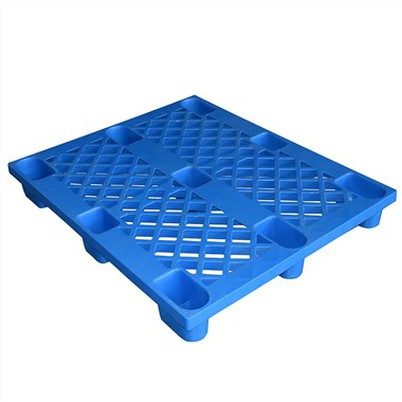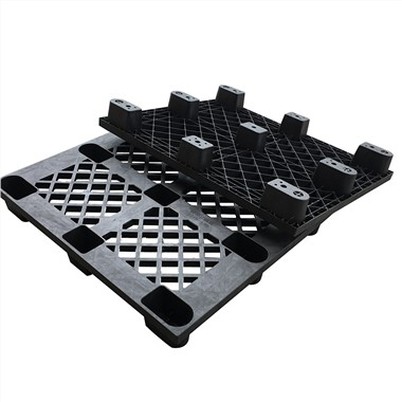How do perforated plastic pallets compare to plastic injection - molded pallets?
Leave a message
In the logistics and warehousing industries, pallets play a crucial role in the efficient movement and storage of goods. Plastic pallets have gained significant popularity due to their durability, cleanliness, and cost - effectiveness compared to traditional wooden pallets. Among plastic pallets, perforated plastic pallets and plastic injection - molded pallets are two common types. As a perforated plastic pallets supplier, I will delve into a detailed comparison between these two types of pallets to help you make an informed decision for your business.
1. Manufacturing Process
- Perforated Plastic Pallets
Perforated plastic pallets are typically made by cutting and shaping pre - fabricated plastic sheets. The perforations are created during the manufacturing process, either by punching holes in the plastic sheets or using a mold with protrusions to form the holes as the plastic is shaped. This process allows for flexibility in creating different hole sizes and patterns according to specific requirements. For example, if a pallet needs to be used in a food processing environment where drainage is important, larger holes can be incorporated into the design. - Plastic Injection - Molded Pallets
Plastic injection - molded pallets are produced through an injection molding process. Molten plastic is injected into a mold cavity under high pressure. Once the plastic cools and solidifies, the pallet is ejected from the mold. This process offers high precision in creating complex shapes and designs. It can produce pallets with consistent quality and dimensions, which is crucial for applications where standardization is required, such as in automated warehousing systems.
2. Structural Design and Strength
- Perforated Plastic Pallets
The perforations in these pallets can have an impact on their strength. While the holes reduce the overall weight of the pallet, they also create areas of weakness. However, modern design techniques can mitigate this issue. For instance, reinforcing ribs can be added around the holes or along the edges of the pallet to enhance its load - bearing capacity. Perforated pallets are generally suitable for lighter loads and applications where the product being transported does not require a high - strength base. - Plastic Injection - Molded Pallets
Injection - molded pallets can be designed with a solid structure or with internal reinforcements, such as honeycomb structures. These designs provide excellent strength and can withstand heavy loads. They are often used in industrial settings where large and heavy items need to be transported, such as in the automotive or machinery industries. For example, an injection - molded pallet can support the weight of a large engine block during its transportation within a factory.
3. Hygiene and Cleanliness
- Perforated Plastic Pallets
The perforations in these pallets offer excellent drainage, which makes them ideal for applications where cleanliness is a priority, such as in the food and beverage industry. Liquids and debris can easily pass through the holes, preventing the accumulation of dirt and bacteria. They can also be easily cleaned by hosing them down, and the open design allows for quick drying. - Plastic Injection - Molded Pallets
Solid - structure injection - molded pallets can also be kept clean, but they may require more effort to clean compared to perforated pallets. However, they are less likely to trap dirt in hard - to - reach areas if they have a smooth surface. In some cases, anti - microbial additives can be incorporated into the plastic during the injection molding process to enhance their hygienic properties.
4. Cost
- Perforated Plastic Pallets
The manufacturing process of perforated plastic pallets is relatively less complex compared to injection - molded pallets. This often results in a lower production cost, making them a more budget - friendly option for businesses. Additionally, their lighter weight can lead to savings in transportation costs. For small and medium - sized enterprises with limited budgets, perforated plastic pallets can be an attractive choice. - Plastic Injection - Molded Pallets
The injection molding process requires expensive molds, which can drive up the initial production cost. However, for large - scale production, the cost per unit can be reduced. The high strength and durability of injection - molded pallets also mean that they have a longer lifespan, which can offset the higher initial cost in the long run.
5. Environmental Impact
- Perforated Plastic Pallets
Since they are often made from recycled plastic materials, perforated plastic pallets have a relatively low environmental impact. The use of recycled plastic helps to reduce the demand for virgin plastic and diverts waste from landfills. Additionally, their lighter weight means less fuel is consumed during transportation, further reducing their carbon footprint. - Plastic Injection - Molded Pallets
Injection - molded pallets can also be made from recycled plastic, but the injection molding process itself consumes more energy compared to the manufacturing process of perforated pallets. However, their long lifespan means that they need to be replaced less frequently, which can reduce the overall environmental impact over time.
6. Versatility
- Perforated Plastic Pallets
Perforated plastic pallets are highly versatile. They can be used in a wide range of industries, including food processing, agriculture, and retail. Their drainage properties make them suitable for applications where moisture needs to be removed, such as in the storage of fresh produce. They can also be customized with different hole patterns and sizes to meet specific requirements. For example, you can find Large Type Splicing Modular Wholesale Plastic Pallet which offers flexibility in assembly and use. - Plastic Injection - Molded Pallets
Injection - molded pallets are also versatile, but their applications are often more focused on heavy - duty and industrial use. They can be designed to fit specific handling equipment, such as forklifts and automated guided vehicles. Standard sizes like Euro Pallet 1200*1000 are widely used in European logistics systems, ensuring compatibility with various transportation and storage facilities.
7. Handling and Mobility
- Perforated Plastic Pallets
The lighter weight of perforated plastic pallets makes them easier to handle manually. They can be quickly moved around in a warehouse or on a loading dock without the need for heavy - duty equipment. However, their perforated design may require special attention when using certain types of handling equipment to prevent damage to the pallet or the product. - Plastic Injection - Molded Pallets
Injection - molded pallets, especially those designed for heavy loads, may require more powerful handling equipment. But their solid structure and standard dimensions make them compatible with a wide range of forklifts and other handling machinery. For example, 4 Way Plastic Pallet allows for easy access from all four sides, improving the efficiency of loading and unloading operations.
In conclusion, both perforated plastic pallets and plastic injection - molded pallets have their own unique advantages and disadvantages. The choice between the two depends on various factors, such as the type of goods being transported, the required strength, hygiene requirements, budget, and environmental considerations. As a perforated plastic pallets supplier, I understand the importance of providing the right solution for each customer's needs. If you are in the process of selecting pallets for your business, I encourage you to contact me for a detailed discussion. We can analyze your specific requirements and recommend the most suitable pallet type for your operations. Whether you need a cost - effective and hygienic solution or a heavy - duty and durable option, we have the expertise to assist you. Let's work together to optimize your logistics and warehousing processes.


References
- Smith, J. (2020). "Plastic Pallets in the Logistics Industry: A Comprehensive Guide". Logistics Journal, 15(2), 45 - 56.
- Brown, A. (2019). "Manufacturing Processes of Plastic Pallets and Their Impact on Quality". Manufacturing Review, 22(3), 78 - 89.
- Green, C. (2021). "Environmental Considerations in the Use of Plastic Pallets". Environmental Science and Logistics, 9(1), 23 - 34.






